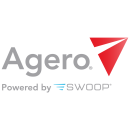They say knowledge is power — so in a workplace where knowledge is shared freely and intentionally, everyone is empowered to succeed.
Transparency is an increasingly sought-after quality in business: Employees are more likely to trust their leadership and feel valued and engaged when they feel informed and included. With more access to information, they can also make better and faster decisions and build a stronger connection to the organization's goals.
For companies, there are also strategic benefits to fostering cultures of open communication: High-trust, collaborative workplaces have been shown to perform better and more readily retain employees.
In recent years, Boston-based Agero has implemented a wide range of initiatives aimed at promoting transparency, including regular informational newsletters and “Ask Me Anything” forums with the company’s CEO. Keri Pajer, Agero’s VP of HR business partner-change initiatives, said the programs are paying dividends in both employee engagement and business results.
“Importantly, we’re seeing an impact in the service we provide to customers,” she told Built In Boston. “The more our people feel empowered through knowledge, the more they have the ability to impact the overall business.”
RapDev’s Elyse Neumeier also attributes much of the company’s efficiency and productivity to maintaining an open dialogue. “Transparency provides our team with the context they need to own their domains, make good decisions and run fast,” she said.
With a transparent culture, employees aren't just along for the ride; they also have a clear view of the road ahead. Below, leaders from Gradient AI and Mainstay, along with Neumeier and Pajer, share how they empower their employees with shared knowledge.

RapDev is a technology and digital transformation consultancy helping organizations deploy code faster.
Please describe the transparent practices in place at your organization in detail.
Transparency and honesty are at the heart of effective communication at RapDev. This goes for both our internal team and our external customers and partners. Internally, all of our conversations, data, challenges and wins are shared. We believe that open Slack channels, accessible dashboards and open-office dialogue build trust and foster learning. No one works in a vacuum: If our leadership team has an offsite workshop, for example, the full notes are shared with the entire organization and we schedule time for questions and follow-up.
With our customers and partners, we know one of the best ways to earn trust is to ensure we maintain that same level of transparency. We keep customers aware of any potential challenges, anything that may impact our ability to deliver and any decisions that may impact timelines. Our strong reputation in our industry is in large part a result of this approach.
We understand how a lack of transparency can erode both trust and productivity, and this is something we work tirelessly to avoid.”
Why were these practices implemented at your organization?
Transparency is one of our four core values, along with creativity, flexibility and culture. We understand how a lack of transparency can erode both trust and productivity, and this is something we work tirelessly to avoid. Keeping information open and accessible enables us to quickly onboard new team members and share learnings across the full team. We don’t waste time with layers of meetings to cascade information, and we can avoid power struggles that arise from information imbalances.
What are the outcomes of this level of transparency? What employee feedback have you received about these practices?
We’ve found that our team really values the level of transparency we promote as a company. While at times it may take a new team member a moment to get comfortable posting their questions in open Slack channels, once they realize how quickly and kindly their teammates respond, they quickly get on board. Transparency breeds a supportive community and an openness within the team that’s not easy to come by.
Agero works with vehicle manufacturers and insurance carriers to provide roadside assistance, accident management and connected vehicle services.
Please describe the transparent practices in place at your organization in detail.
We relaunched our corporate intranet to make it an easily accessible information hub with links to other key partners and resources. We initiated weekly and monthly newsletters to provide proactive, just-in-time information to our associates and instituted regular all-associate town halls and leadership meetings. In particular, our CEO “Ask Me Anything” sessions have changed the trajectory of how we communicate with everyone in the organization by giving associates a space to ask hard questions and get answers that help build trust.
We have worked hard at fostering a more engaging culture focused on a continuous learning and conversation journey, including regular pulse surveys. Key to this is asking the right questions and ensuring we provide a timely and action-oriented response. We also have focused on efforts around DEI and wellness, creating a space where employees feel respected, welcomed and empowered to learn.
Transparency is core to our strategy for our clients, customers, associates and third-party providers. The very foundation of our products is the ability to deliver clear, impactful insights and information to all who need it.
Transparent communication is foundational for employees to understand the business and their role within it.”
Why were these practices implemented at your organization?
Like many companies, as we talked to our employees, we heard they valued more timely and transparent communication. The evolving needs of our associates and our business both required more intentional transparency.
Additionally, when COVID hit, we turned to our employees for help. They wanted increased access to information and ways to stay connected, especially in a remote environment. The increased level of transparency bridged the gap and created an environment where employees feel seen and heard, and led to the next chapter of our journey.
Our strategy continues to evolve. Transparent communication is foundational for employees to understand the business and their role within it.
What are the outcomes of this level of transparency? What employee feedback have you received about these practices?
Our ability to be agile has changed because our people feel more in the know about what the business is doing and what they should expect. We see this in day-to-day interactions: Meetings have changed, time together has changed and our communication is more productive and direct. We have set people up for success in working together and staying informed. As our business’ and employees' needs evolve, so will we.
Gradient AI offers artificial intelligence solutions to help insurers automate their processes, make data-backed decisions and predict outcomes more accurately.
Please describe the transparent practices in place at your organization in detail.
As the leader of Gradient AI, I prioritize keeping our team informed of updates or important changes to our organization. To achieve this, we host company-wide virtual happy hours once every two weeks, where leaders share product updates, role changes and any important organization-wide information. Annually, we ask our team to come to our headquarters in Boston to share how well the company did over the last year and how we plan to grow in the coming year.
To foster open communication, the Gradient AI leadership team operates with an open-door policy. I believe that ensuring that employees are well-informed and have access to information is essential because when people are left in the dark, they tend to assume the worst.
Why were these practices implemented at your organization?
At Gradient AI, we are committed to upholding our core values, and one of them is to encourage everyone to do the right thing. When I was an employee, I found that being open and transparent was essential for building trust and promoting engagement. As a result, I prioritize establishing a culture of transparency at Gradient AI to keep our team informed of updates and significant organizational changes while empowering them to contribute to the company's growth.
By being open with our team, we have created an environment where everyone can focus on their work and put their energy into helping our company grow.”
What are the outcomes of this level of transparency? What employee feedback have you received about these practices?
Our employee surveys regularly highlight an appreciation for transparency and open communication from leaders. By being open with our team, we have created an environment where everyone can focus on their work and put their energy into helping our company grow. Transparency has also helped us navigate the uncertainties that come with running a start-up, allowing us to move forward with clarity and confidence.
Mainstay is a student and employee engagement platform powered by conversational AI.
Please describe the transparent practices in place at your organization in detail.
Mainstay has committed to fostering a company culture of transparency through routine and systematized data sharing and reporting across all levels of our organization.
Monthly and quarterly, we produce a 360-degree business review for our internal teams across each of our functional areas. This exercise provides an overview of performance, evaluated against key performance indicators, company goals and initiatives and areas of opportunity for specific improvement.
Weekly, we produce a focused business review for the executive team and our senior management. These reviews hold each leader accountable for the day-to-day focuses but also identify challenge areas as they develop.
We publish our salary bands internally, as many organizations do. But the data focus has allowed us to take it a step further and produce reporting for our entire organization about pay and promotion equity — even when we haven't lived up to our own hype.
Transparency has been well-received, but our employees have also reminded us that transparency without accountability cannot drive change.”
Why were these practices implemented at your organization?
Being open and honest about areas of opportunity for improvement or where we have fallen short of driving sufficient impact is deeply aligned with our corporate values.
From a business perspective, transparency across the organization speeds up innovation and drives accountability and effectiveness. For example, our sales team can see which customer segments our customer success team has more trouble renewing, which informs their understanding of our value proposition and guides how they set expectations with potential customers. Similarly, our customer success team can see the sales funnel and conversions, enabling them both to produce resourcing plans and to identify existing customers who may be good references for our sales team's current pipeline.
What are the outcomes of this level of transparency? What employee feedback have you received about these practices?
Our organization is constantly hungry for more data and visibility into what they are doing and what their teammates around them are doing.
Transparency has been well-received, but our employees have also reminded us that transparency without accountability cannot drive change. Taking transparency to the actionable next steps is always our focus for the future.












